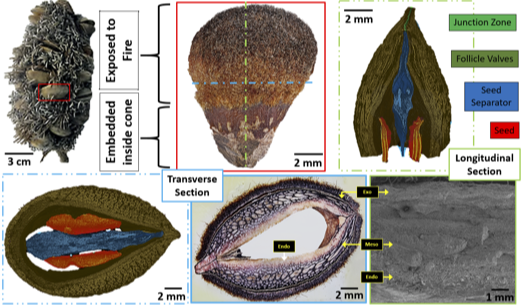Multimodal Coatings For Heat And Fire Resistance
Patent Status
| Country | Type | Number | Dated | Case |
| United States Of America | Issued Patent | 12460092 | 11/04/2025 | 2019-104 |
Full Description
Background
Current protective coatings or materials are incapable of prolonged shielding and maintaining structural integrity at temperatures above 600°C and/or are made using environmentally unfriendly methods. In some applications, coatings are applied to surfaces to reduce damage through adding an extra layer of protection. These coatings are either ablative, intumescent, or thick ceramic cements. Ablative coatings cannot provide prolonged protection in hostile environments. Intumescent polymer coatings suffer from poor adherence and are environmentally toxic because of the presence of bio-accumulators such as halogens and bromines.
Current Invention
Prof. David Kisailus and his team, inspired by the fire-resistant seeds of the plant Banksia speciosa, have developed a multitude of novel structural design components that provide mechanical toughness along with thermal shielding to ensure durability and improved damage tolerance at hostile temperatures.

A photograph of a Banksia Speciosa cone, and its inner cross-section revealing the inner structure - the thermally resistant follicle valve, the seeds encapsulated within the follicle, and the seed separator membrane flanking the seeds.
Advantages
The novelty of these designs is that they are:
Suggested uses
- Structural materials for aerospace or automotive composites.
- Sports or personal protective gear.
- Construction panels that absorb heat.
- Lightweight, heat resistant wearable fabric for firefighter uniforms.
- Composites for jet engine blades.
Inventions by David Kisailus
Contact
- Venkata S. Krishnamurty
- venkata.krishnamurty@ucr.edu
- tel: View Phone Number.
Other Information
Keywords
Coatings, Thermal resistance, Fire resistance, Flame retardation, Heat absorption, Biomimicry, Wearables, Firefighter uniforms, Jet engine blades
